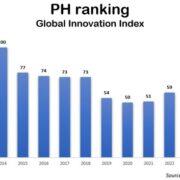China Lianhe Credit Rating Co. Ltd. has affirmed the “AAA” long-term issuer rating of the Philippines, bestowing the highest level of confidence in the country’s ability to service financial obligations despite the toll caused by the pandemic.
According to Lianhe’s sovereign credit rating methodology, a “AAA” rating indicates that a creditor has extremely strong capacity to pay its financial commitments; is highly unlikely to be affected by adverse economic conditions; and has the lowest expectation of default risk.
The Chinese debt watcher also affirmed the “stable” outlook on the rating, which signals a low likelihood of a rating change over the short term.
This latest rating action from Lianhe bodes well for the Philippines’ ability to continue accessing financing from Chinese investors, such as via sale of government bonds, at low interest rates.
The Philippine government had issued Panda bonds as part of its efforts to diversify funding sources.
The Philippines’ maiden issuance of RMB 1.5 (USD 230 million) in 2018 was met with strong demand and was priced at just 35 bps above the benchmark. Of all sovereigns, the issuance had the most oversubscribed order book of 6.3 times the offer at the time of the issuance.
In 2019, the Philippines raised RMB 2.5 billion (USD 363 million) from its second sale of Panda bonds that similarly saw strong demand from investors. The three-year debt fetched a 3.58 percent coupon that represented a tight spread of just 32 basis points above the benchmark. The order was 4.5 times oversubscribed, reaching a total of RMB 11.25 billion.
In its latest report on the Philippines released on 28 July 2021, Lianhe noted that the Philippines, like many countries across the globe, suffered a recession because of the pandemic. Nevertheless, it said, the Philippines has kept the impact of the pandemic on its finances manageable—aided in part by revenues generated from tax reforms—and is headed toward recovery.
“Although the fiscal deficit widened further, government debt remained within acceptable threshold…Looking forward, the Philippines’ economic and fiscal performances are expected to recover in 2021 and 2022 on the back of gradually easing pandemic and continuous tax reforms,” Lianhe said. It expects the Philippines to have a GDP growth of around 7 percent in 2021 and 2022.
In response, Finance Secretary Carlos Dominguez said, “We thank Lianhe for giving us the highest level of seal of good housekeeping. This is an affirmation of the Philippines’ robust fiscal position–resulting from President Duterte’s prudent fiscal policy and game-changing initiatives such as tax reforms–that will enable the country to pull through the pandemic damage.”
“The importance of fiscal discipline cannot be overly emphasized. Because of it, the Philippines has enjoyed creditor and investor confidence, which has led to favorable terms like lower interest rates on government borrowings and, therefore, more space in the national budget for vital expenditures like infrastructure, social services, and COVID-19 response,” Dominguez said.
“Meantime, part of our debt management strategy is to diversify our sources of financing, such as by issuing bonds in different markets. While China accounts for a relatively small portion of the Philippines’ outstanding debt, the ‘Triple A’ rating from Lianhe helps ensure continued warm reception of the Chinese market to potential bond issuances of the Philippine government in the future.”
In its rating report, Lianhe cited the following strengths of the Philippine economy: i) cash remittances from overseas Filipinos and revenues from IT-BPM industry showed resilience amid the pandemic, contributing to the country’s ability to earn foreign exchange; ii) external debt remained at a low level, and the capacity to repay these obligations is underpinned by ample current account receipts and foreign reserves; iii) long track record of fiscal prudence with government debt maintained within acceptable threshold despite a sharp increase in 2020; and iv) stable source of repayment from increasing government revenues.
Expounding on its favorable assessment of the Philippines, Lianhe noted in its report that the “Bangko Sentral ng Pilipinas expects remittances to grow by 4.0 percent in 2021 and 2022”.
As the pandemic is gradually brought under control and the global economy recovers, the debt watcher cited in its report that “the local industry association estimates the Philippines’ BPO sector to grow by 5 percent to 6.5 percent in 2021”.
Lianhe also noted the Philippines’ relatively low external debt and rising government revenues, which the country’s finance officials attribute to recent tax reforms such as the Tax Reform for Acceleration and Inclusion (TRAIN) and the sin tax measures.
“The debt structure of the Philippines remains relatively stable in 2020. Ample domestic liquidity has allowed the country to source from domestic markets to fund the majority of its financing requirements while minimizing foreign exchange risks. Domestic debts accounted for 68.3% of the total at end-2020”, the rating agency said.
It also noted that “the continuous implementation of comprehensive tax reform has improved fiscal sustainability of the Philippines against the background of the COVID-19 pandemic…The Philippines will return to fiscal consolidation when the adverse impact of the pandemic abates, and the economy will resume its long-run average growth path.
–
Stay updated with news and information from the Investor Relations Office of the Philippines by visiting their website at https://iro.ph.






